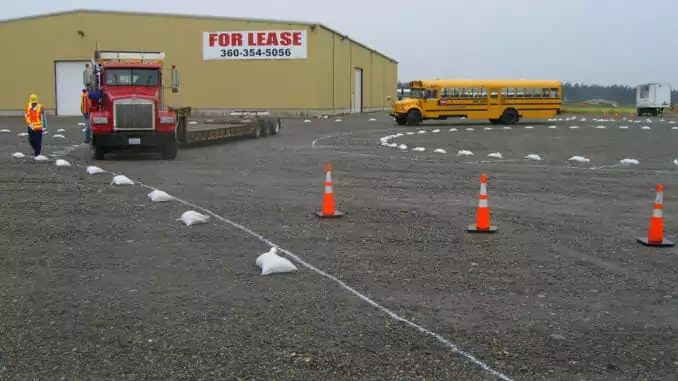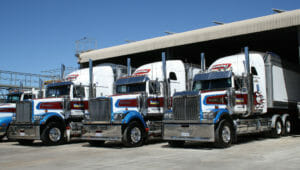
You’ve gotten one or more truck driver pre-hire letters, and you’re ready to attend a trucking company’s orientation. You’ve proven you have the drive to succeed in the trucking industry. Now… you’re wondering what to expect.
What Is Trucking Company Orientation?
Trucking company orientation is the time a potential new hire gets to know a potential employer. If an applicant wants to drive for that business, the driver uses that time to prove their worth to the particular carrier.

During orientation, you can expect introductions, breakfast, paperwork, tests, in-truck training, on-the-road training, and more. Arrive on time – which means 15 minutes early – for anything they schedule.
Be honest about everything, including questions about your background. If you have a felony or anything on your record, the trucking company will find it eventually.
Bring copies of your original paperwork. Present yourself professionally and have fun.
Consider contacting the trucking company and asking them for details about the orientation’s itinerary, if they have one, and what you should expect because each company can be different in their approach to hiring new drivers.
Where Is Orientation Held?
Trucks are big, so these facilities are enormous! These over-the-road (OTR) truck-driving jobs begin with orientation at one of the company’s sites.
Being in the trucking company facility helps to familiarize potential new hires with the size, shape, personnel, and nooks and crannies of the carrier’s operation. Some trucking businesses have their first day—or paperwork day—in a conference room at the hotel or motel where the drivers are staying.
The majority of orientation will happen on site among the drivers, trainers and rigs.
How Long Is Trucking Company Orientation?
Over-the-road truck driving jobs are serious business, requiring much knowledge and great safety. For those reasons orientation can last a long time for applicants newly holding the Class A CDL.
The truck driver pre-hire letters bring in new CDL holders as well as experienced drivers. All applicants will have to go through the paperwork just like any other new job. Depending on the carrier, the new CDL holders might have to log more hours of over-the-road driving with a trainer than an experienced CDL holder. On average, expect the entire orientation process 3-7 days.
What Happens at Orientation?
Excitement fills the air for those who have arrived at and are preparing to stay the night at a hotel. Don’t make the mistake of celebrating too early with other candidates.

Arriving late the first morning is enough for some carriers to dismiss a potential truck driver with a pre-hire letter. They will most certainly dismiss those who arrive late with alcohol or anything else suspicious on their breath.
Instead, arrive early with original paperwork to ensure a smooth and seamless day of filling out forms. The carrier will cross reference your first application with the one you fill out at orientation, and any discrepancies will raise red flags or be cause for dismissal.
During orientation, you get practice filling out log books even if the carrier has eLogs on their rigs. Time is spent reviewing the permit book and other basic administrative paperwork, like filling out information for insurance on yourself and your dependents.
After the paperwork is complete, be prepared to view a barrage of safety videos. Are they boring? Well, yes and no and maybe. Are they important? Absolutely, because no one wants to be responsible for the death of other motorists.
These videos will cover topics such as Hours of Service, driver wellness, Inter- versus Intrastate Highway driving, and everything that could become a hazard for a driver or get him fired.
The next couple of days — or more, depending on the carrier — applicants experience in-truck training on site and on the road. This includes a lot of pre-trip inspections, repetitive maneuvering, backing, offset backing, coupling and uncoupling of trailers, and careful cruises on local roads and highways.
Keep cool, go slow, knock it all out, and prepare for the next step: for new CDL holders, this means logging hours driving over-the-road with an OTR trainer, or “training engineer.”
After on-the-road training, some trucking businesses follow up with a little more administrative practice on items like trip planning, the eLog system, GPS, and sometimes a final skills qualification test on all the material covered throughout the orientation.
What Do I Bring to Trucking Company Orientation?
Over-the-road truck driving jobs are in a class all by themselves. Knowing what to bring will provide for a comfortable orientation, which can maintain and/or boost confidence during this time.
Your clothing should be professional-casual, such as khaki pants or nice denim, a belt, work boots, clean collared shirts or blouses and work gloves. You will be staying overnight so bring appropriate pajamas—just don’t wear them out of the hotel.
In addition to your clothes, the following list simplifies what to bring:
- Original/copy of your Birth Certificate
- Original/copy of your and your dependents’ Social Security Numbers
- Original/copy of first application
- Truck Driver Pre-Hire Letter for current carrier and competitors
- List of other references
- Truck Driver school Graduation Certification
- Loan agreement/contract, School receipt
- Discharge papers from military
- Cash and/or credit cards for emergencies
- Paper, pen, pencil, binder, book bag
- Clothes, toiletries (earplugs for snoring roommate), laundry bag
- Snacks, bottles of water
- Tablet, smart phone, something with internet connectivity
Who Pays?
Typically the carrier pays the transportation, lodging, and some or all of the food—usually breakfast and lunch. Trucking companies are not all the same, so call ahead and ask what is covered—some big businesses will even fly out applicants!
Also, some carriers hiring for over-the-road truck driving jobs have applicants pay for some of the expenses which they will reimburse later, so keep all of your receipts.
If you have your truck driver pre-hire letter, get excited, get ready with questions for your potential employer, and get out on that road!
